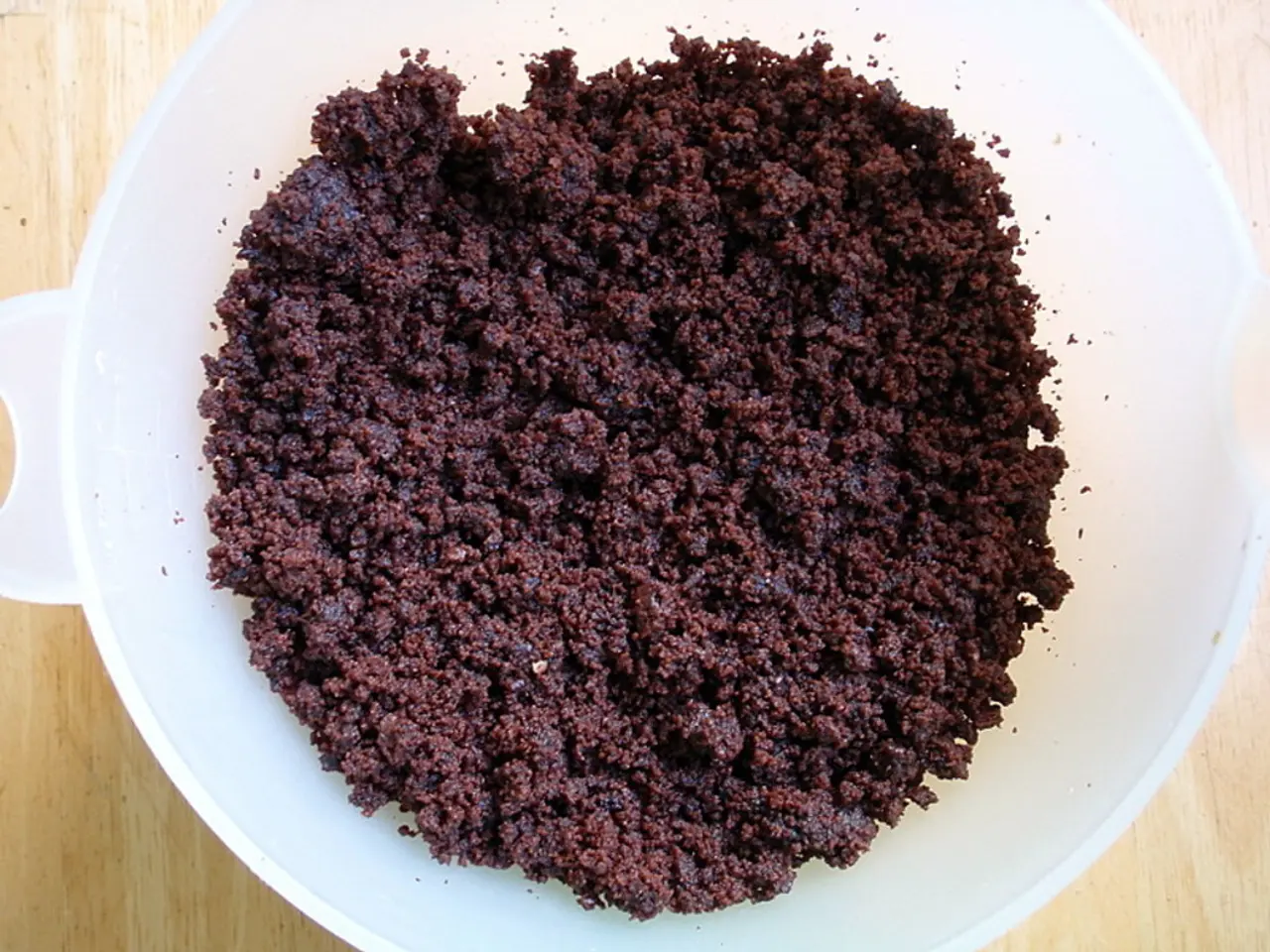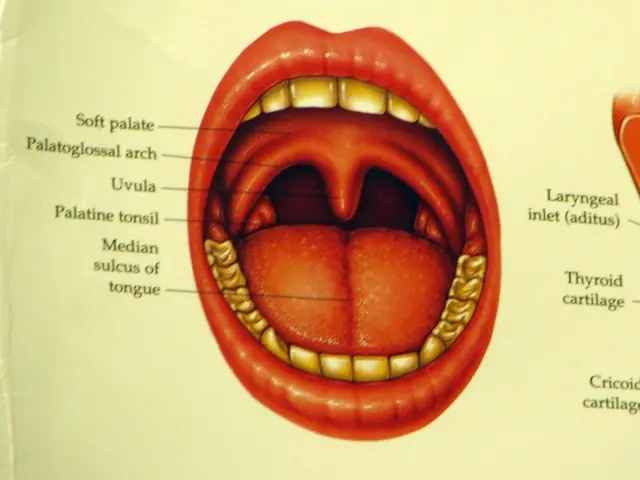Stool characteristics, symptoms, and therapeutic approaches for ulcerative colitis
Ulcerative colitis (UC), a long-term inflammatory bowel disease, can significantly affect a person's stool texture, composition, and frequency. This article aims to provide a clear understanding of the common stool changes observed in individuals with UC and the associated symptoms.
One of the most notable stool changes in UC is **diarrhea or loose stools**, which may occur more than four times a day during flare-ups. This is due to the inflamed intestinal wall causing the muscles in the colon to contract more frequently, pushing stool through faster [2][3].
Another common symptom is **bloody stools**, which can range in appearance from bright red to pink or tarry. This is a result of ulcers that form within the lining of the colon bleeding [2][3].
**Mucus discharge in the stool** is also a common occurrence, as the inflamed intestinal lining produces excess mucus [1][2]. In some cases, the stool may take on a **ribbon-like shape** due to long-standing inflammation leading to narrowing of the intestines [2].
UC patients often experience **frequent bowel movements with urgency**, accompanied by the sensation of **tenesmus**, a constant feeling of needing to evacuate even after defecation [1][2][3].
These stool abnormalities are typically accompanied by other common symptoms such as **abdominal cramps and pain**, often triggered or worsened by bowel movements [1][2][3]. **Rectal pain or discomfort** during bowel movements is also common [3].
Systemic symptoms including **fever, weight loss, loss of appetite, and fatigue** are also observed, reflecting the inflammatory nature and impact of UC on overall health [3][4].
It's important to note that people with UC may also experience other symptoms such as loss of appetite, weight loss, anemia, eye issues, mouth sores, joint pain and swelling, and skin problems such as rashes or sores.
In managing UC, it's crucial to understand the various treatments available. Immunomodulators, biologics, aminosalicylates, and corticosteroids are some of the medications used to regulate the immune system, target inflammation, and provide fast-acting anti-inflammatory relief [1]. Prebiotics and certain probiotics may also help reduce symptoms by improving the gut microbiome [6].
For those experiencing bowel incontinence, pelvic floor exercises can help strengthen the muscles around the anus, reducing incontinence. In severe cases, surgery may be necessary [7].
Lastly, it's essential to remember that a person who regularly loses a lot of blood in their stool may develop anemia, and iron supplements may be prescribed to prevent this [5].
Squatting while having a bowel movement can help align the rectum, making stool easier to pass [8]. If experiencing any of these symptoms, it's crucial to consult a healthcare professional for proper diagnosis and treatment.
References: [1] Crohn's & Colitis Foundation of America. (n.d.). Ulcerative Colitis. Retrieved from https://www.ccfa.org/what-are-crohns-and-colitis/disease-information/ulcerative-colitis [2] Mayo Clinic Staff. (2020, May 18). Ulcerative colitis. Retrieved from https://www.mayoclinic.org/diseases-conditions/ulcerative-colitis/symptoms-causes/syc-20356033 [3] National Institute of Diabetes and Digestive and Kidney Diseases. (2019, September). Ulcerative Colitis. Retrieved from https://www.niddk.nih.gov/health-information/digestive-diseases/ulcerative-colitis [4] National Institute of Diabetes and Digestive and Kidney Diseases. (2019, September). Symptoms & Causes of Ulcerative Colitis. Retrieved from https://www.niddk.nih.gov/health-information/digestive-diseases/ulcerative-colitis/symptoms-causes [5] National Institute of Diabetes and Digestive and Kidney Diseases. (2019, September). Treatments for Ulcerative Colitis. Retrieved from https://www.niddk.nih.gov/health-information/digestive-diseases/ulcerative-colitis/treatment [6] National Institute of Diabetes and Digestive and Kidney Diseases. (2019, September). Diet and Nutrition for Ulcerative Colitis. Retrieved from https://www.niddk.nih.gov/health-information/digestive-diseases/ulcerative-colitis/diet-nutrition [7] National Institute of Diabetes and Digestive and Kidney Diseases. (2019, September). Surgery for Ulcerative Colitis. Retrieved from https://www.niddk.nih.gov/health-information/digestive-diseases/ulcerative-colitis/surgery [8] National Institute of Diabetes and Digestive and Kidney Diseases. (2019, September). Managing Diarrhea. Retrieved from https://www.niddk.nih.gov/health-information/digestive-diseases/managing-diarrhea
- Obesity and type 2 diabetes, both chronic diseases, are often associated with ulcerative colitis, increasing the risk of degeneration and complications.
- Increased age can also contribute to the development of ulcerative colitis and chronic kidney disease, making the role of medical-conditions and workplace-wellness in preventive care even more important.
- The macular area of the eye can be affected by type-2 diabetes, leading to potential vision problems related to eye-health.
- In addition to digestive symptoms like constipation and diarrhea, respiratory conditions such as COPD may also develop due to the inflammatory nature of ulcerative colitis.
- The inflammation in the eye can also impact health-and-wellness, as it can lead to vision loss or blurred vision.
- Fitness-and-exercise, an essential part of maintaining overall health, can help manage chronic diseases like ulcerative colitis and type-2 diabetes by improving nutrition and reducing obesity.
- Mental-health is closely linked to overall health, and managing stress can contribute to better management of chronic diseases such as ulcerative colitis and type-2 diabetes.
- Skin-care becomes crucial for people with ulcerative colitis as they may experience rashes or sores due to the inflammatory nature of the disease.
- Therapies-and-treatments such as immunomodulators, biologics, and aminosalicylates can help regulate the immune system and reduce inflammation in ulcerative colitis.
- Prebiotics and certain probiotics have shown promise in reducing symptoms of ulcerative colitis by improving the gut microbiome and digestive health.
- In many cases, a colonoscopy is used for predictive purposes in diagnosing and monitoring ulcerative colitis, as it allows for a direct view of the colon and identification of any ulcers.
- Despite the potentially debilitating effects of ulcerative colitis, regular screenings and effective treatments can help manage symptoms and improve quality of life.
- Early intervention through proper nutrition can help control symptoms associated with ulcerative colitis and improve the overall health and well-being of affected individuals.
- The sports industry has a role in promoting workplace-wellness and fitness-and-exercise, which can help in the prevention and management of chronic diseases like ulcerative colitis and type-2 diabetes.
- Managing chronic diseases like ulcerative colitis and type-2 diabetes requires a comprehensive approach, incorporating medication, diet, exercise, mental-health support, and regular medical screenings, to ensure optimal health and wellness.




